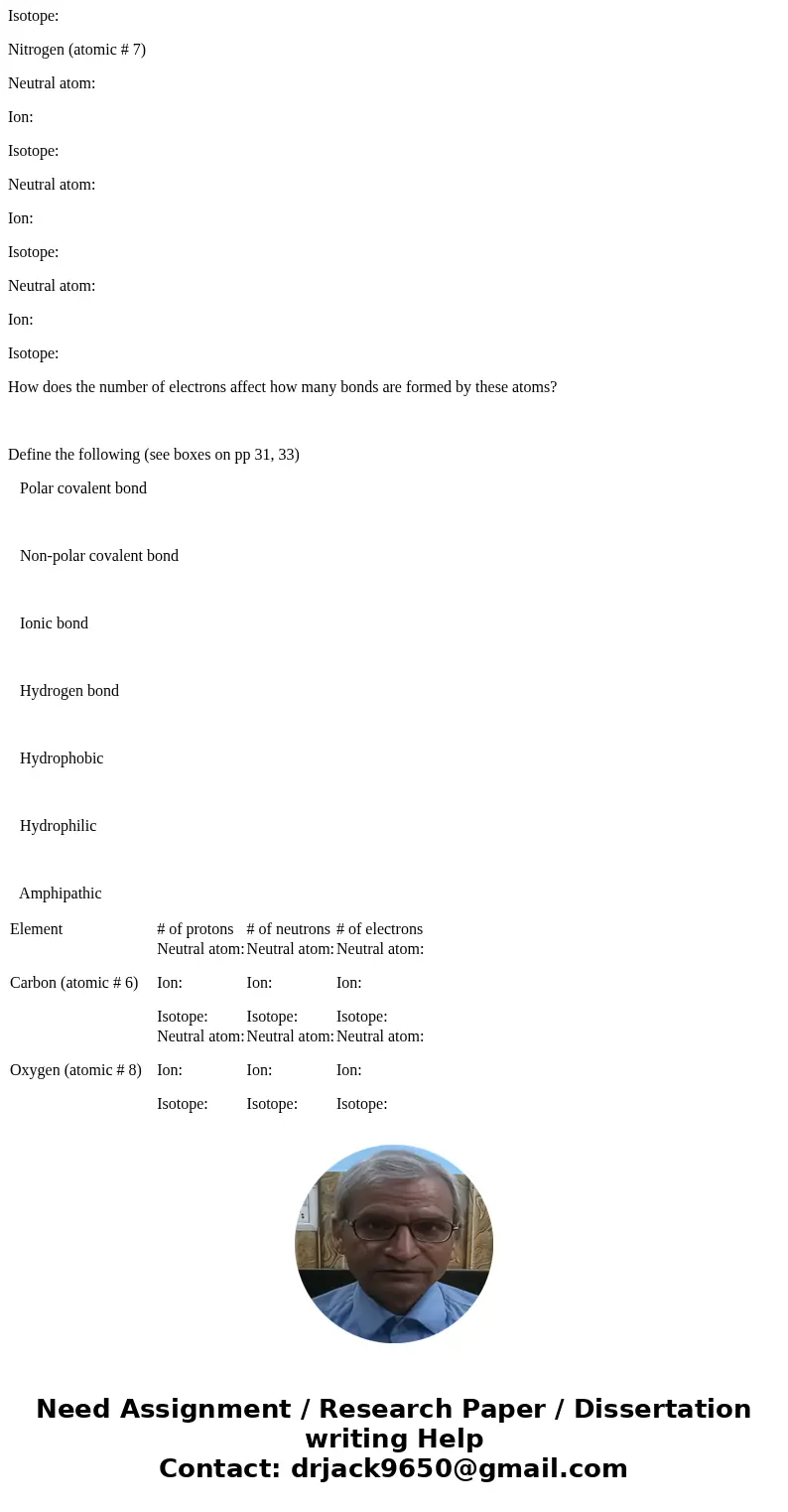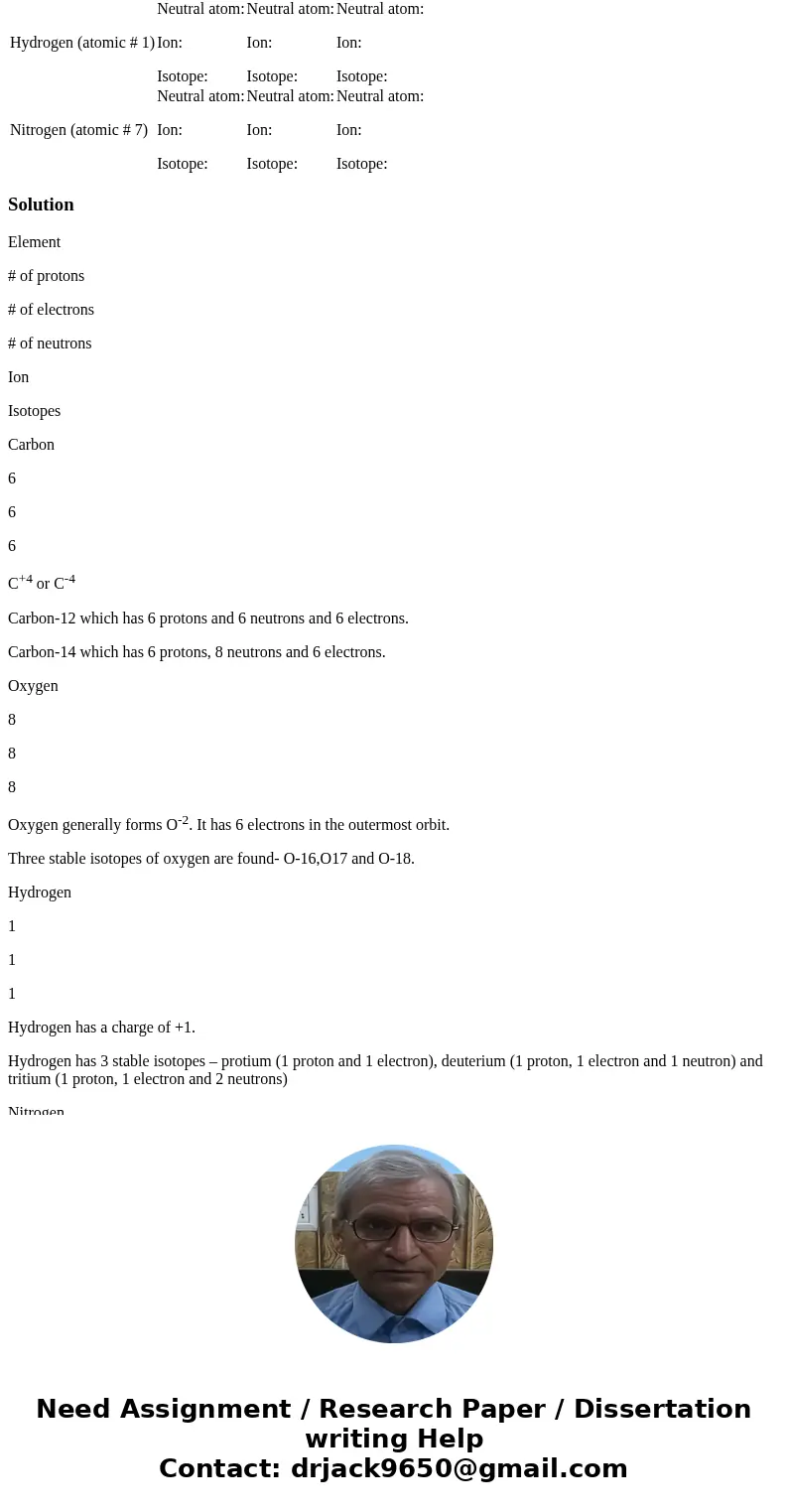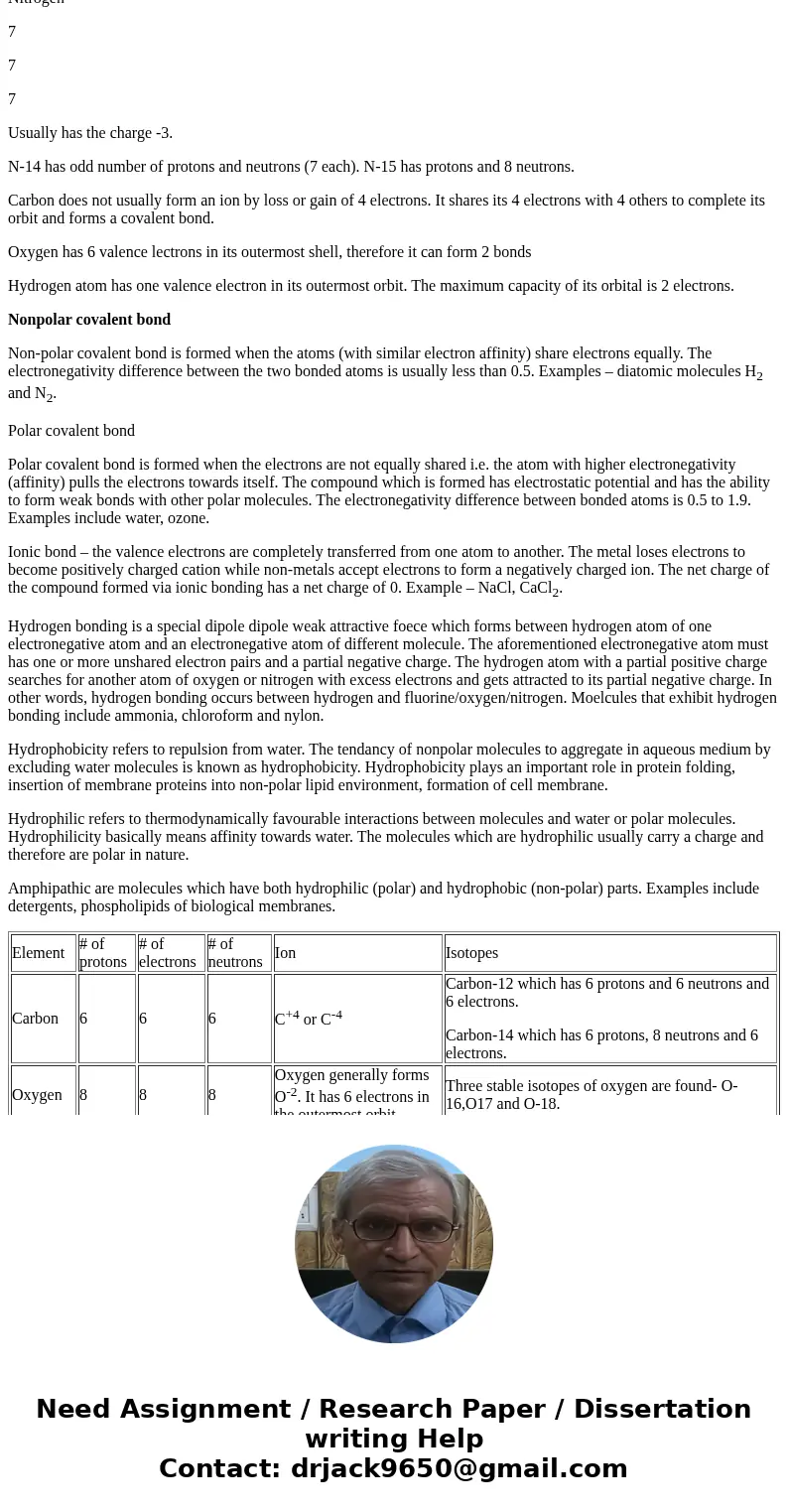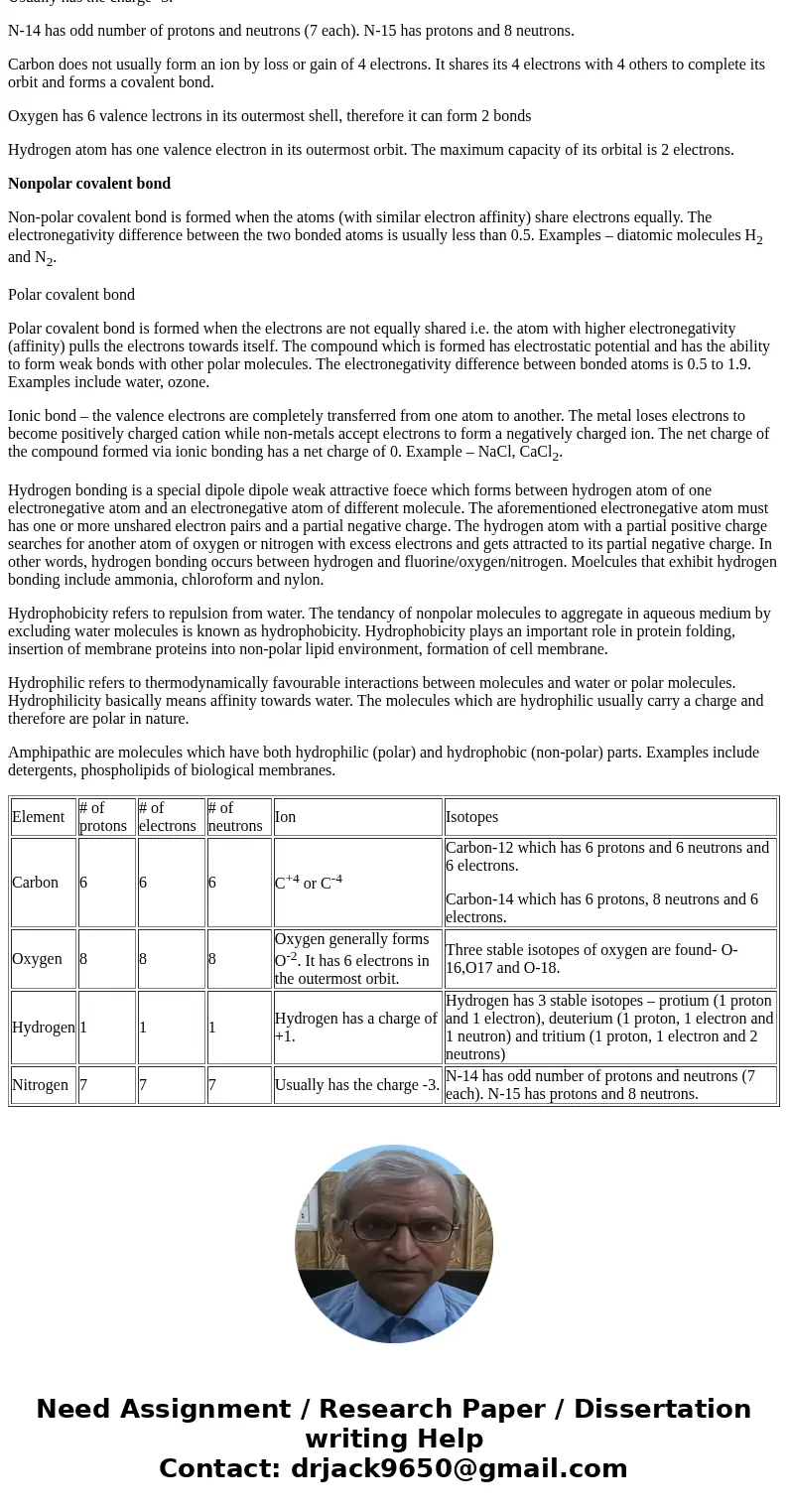Element of protons of neutrons of electrons Carbon atomic
Element
# of protons
# of neutrons
# of electrons
Carbon (atomic # 6)
Neutral atom:
Ion:
Isotope:
Neutral atom:
Ion:
Isotope:
Neutral atom:
Ion:
Isotope:
Oxygen (atomic # 8)
Neutral atom:
Ion:
Isotope:
Neutral atom:
Ion:
Isotope:
Neutral atom:
Ion:
Isotope:
Hydrogen (atomic # 1)
Neutral atom:
Ion:
Isotope:
Neutral atom:
Ion:
Isotope:
Neutral atom:
Ion:
Isotope:
Nitrogen (atomic # 7)
Neutral atom:
Ion:
Isotope:
Neutral atom:
Ion:
Isotope:
Neutral atom:
Ion:
Isotope:
How does the number of electrons affect how many bonds are formed by these atoms?
Define the following (see boxes on pp 31, 33)
Polar covalent bond
Non-polar covalent bond
Ionic bond
Hydrogen bond
Hydrophobic
Hydrophilic
Amphipathic
| Element | # of protons | # of neutrons | # of electrons |
| Carbon (atomic # 6) | Neutral atom: Ion: Isotope: | Neutral atom: Ion: Isotope: | Neutral atom: Ion: Isotope: |
| Oxygen (atomic # 8) | Neutral atom: Ion: Isotope: | Neutral atom: Ion: Isotope: | Neutral atom: Ion: Isotope: |
| Hydrogen (atomic # 1) | Neutral atom: Ion: Isotope: | Neutral atom: Ion: Isotope: | Neutral atom: Ion: Isotope: |
| Nitrogen (atomic # 7) | Neutral atom: Ion: Isotope: | Neutral atom: Ion: Isotope: | Neutral atom: Ion: Isotope: |
Solution
Element
# of protons
# of electrons
# of neutrons
Ion
Isotopes
Carbon
6
6
6
C+4 or C-4
Carbon-12 which has 6 protons and 6 neutrons and 6 electrons.
Carbon-14 which has 6 protons, 8 neutrons and 6 electrons.
Oxygen
8
8
8
Oxygen generally forms O-2. It has 6 electrons in the outermost orbit.
Three stable isotopes of oxygen are found- O-16,O17 and O-18.
Hydrogen
1
1
1
Hydrogen has a charge of +1.
Hydrogen has 3 stable isotopes – protium (1 proton and 1 electron), deuterium (1 proton, 1 electron and 1 neutron) and tritium (1 proton, 1 electron and 2 neutrons)
Nitrogen
7
7
7
Usually has the charge -3.
N-14 has odd number of protons and neutrons (7 each). N-15 has protons and 8 neutrons.
Carbon does not usually form an ion by loss or gain of 4 electrons. It shares its 4 electrons with 4 others to complete its orbit and forms a covalent bond.
Oxygen has 6 valence lectrons in its outermost shell, therefore it can form 2 bonds
Hydrogen atom has one valence electron in its outermost orbit. The maximum capacity of its orbital is 2 electrons.
Nonpolar covalent bond
Non-polar covalent bond is formed when the atoms (with similar electron affinity) share electrons equally. The electronegativity difference between the two bonded atoms is usually less than 0.5. Examples – diatomic molecules H2 and N2.
Polar covalent bond
Polar covalent bond is formed when the electrons are not equally shared i.e. the atom with higher electronegativity (affinity) pulls the electrons towards itself. The compound which is formed has electrostatic potential and has the ability to form weak bonds with other polar molecules. The electronegativity difference between bonded atoms is 0.5 to 1.9. Examples include water, ozone.
Ionic bond – the valence electrons are completely transferred from one atom to another. The metal loses electrons to become positively charged cation while non-metals accept electrons to form a negatively charged ion. The net charge of the compound formed via ionic bonding has a net charge of 0. Example – NaCl, CaCl2.
Hydrogen bonding is a special dipole dipole weak attractive foece which forms between hydrogen atom of one electronegative atom and an electronegative atom of different molecule. The aforementioned electronegative atom must has one or more unshared electron pairs and a partial negative charge. The hydrogen atom with a partial positive charge searches for another atom of oxygen or nitrogen with excess electrons and gets attracted to its partial negative charge. In other words, hydrogen bonding occurs between hydrogen and fluorine/oxygen/nitrogen. Moelcules that exhibit hydrogen bonding include ammonia, chloroform and nylon.
Hydrophobicity refers to repulsion from water. The tendancy of nonpolar molecules to aggregate in aqueous medium by excluding water molecules is known as hydrophobicity. Hydrophobicity plays an important role in protein folding, insertion of membrane proteins into non-polar lipid environment, formation of cell membrane.
Hydrophilic refers to thermodynamically favourable interactions between molecules and water or polar molecules. Hydrophilicity basically means affinity towards water. The molecules which are hydrophilic usually carry a charge and therefore are polar in nature.
Amphipathic are molecules which have both hydrophilic (polar) and hydrophobic (non-polar) parts. Examples include detergents, phospholipids of biological membranes.
| Element | # of protons | # of electrons | # of neutrons | Ion | Isotopes |
| Carbon | 6 | 6 | 6 | C+4 or C-4 | Carbon-12 which has 6 protons and 6 neutrons and 6 electrons. Carbon-14 which has 6 protons, 8 neutrons and 6 electrons. |
| Oxygen | 8 | 8 | 8 | Oxygen generally forms O-2. It has 6 electrons in the outermost orbit. | Three stable isotopes of oxygen are found- O-16,O17 and O-18. |
| Hydrogen | 1 | 1 | 1 | Hydrogen has a charge of +1. | Hydrogen has 3 stable isotopes – protium (1 proton and 1 electron), deuterium (1 proton, 1 electron and 1 neutron) and tritium (1 proton, 1 electron and 2 neutrons) |
| Nitrogen | 7 | 7 | 7 | Usually has the charge -3. | N-14 has odd number of protons and neutrons (7 each). N-15 has protons and 8 neutrons. |





 Homework Sourse
Homework Sourse